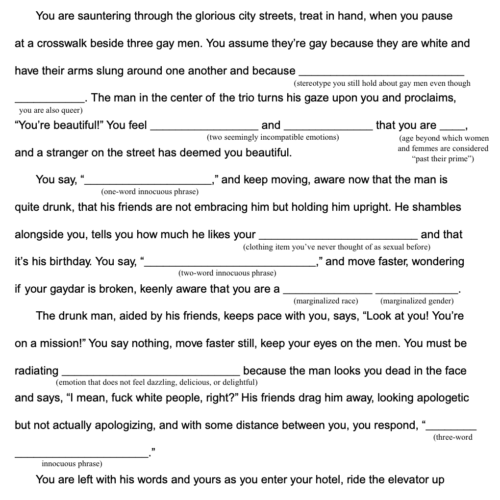Sunlight filters through the stained glass windows amidst the tall columns supporting the ceiling of Iglesia de la Merced—built in 1534 by the Spanish conquerors of Nicaragua—and illuminates the altar of Virgen de Fatima. I find my mother there, standing before a giant sculpture of the crucifixion. The Son on the cross, his mother by his side. Both silent. My mom’s eyes are closed, her head bowed, and her tiny ponytail bounces up and down as she chants something to herself.
“Jay Shree Krishna, Jesus Christ,” she says, then repeats a few times.
My head tilts a few degrees, like a bird caught off guard. “What are you doing, Mom?”
We are on a family vacation, finally. Even though I talk to my parents daily, it has been nearly a decade since we went on vacation together, our calendars covered with so many overlapping brushstrokes that there is no white space. We rarely spend entire days of leisure with each other. Yes, we talk, but it is rare that we actually talk. But here we were in Central America: my parents and I, my husband, our young daughters, my sister and her boyfriend; only my brother is missing, captive to his unforgiving medical school schedule.
Three days ago, we landed in San Jose, Costa Rica, and as we collected our bags and buckled our seatbelts in the transport to the hotel, I felt myself mother and daughter at once, stitched securely in the middle of our family quilt, safe from fraying or falling away. In the few days since then, we’ve enjoyed a group boat ride before we split up, with some off to the pool and others to a ziplining outing. When the hotel offered a one-day excursion to the old city of Granada in Nicaragua, with its 14th-century cathedral, my dad said, “Let’s go. We can do this together.”
Standing next to my mother in the cathedral, I feel both bemused and curious. I expected to visit churches in Central America. I didn’t expect my Hindu mom to pray in them.
My mother answers me in a whisper. “Jesus is a God also. We respect all Gods.” She continues in our native language, Gujarati: “See how he suffered?”
My mother grew up in Vadodara, India, a town more cosmopolitan than my dad’s farming village of Panetha, but provincial compared to megacities like Mumbai and Delhi. Religion was everywhere in India, my mother told me when we once visited her hometown. Growing up, she walked past roadside temples, mosques, and churches on the way to school. Prayer was a part of day-to-day life, anywhere you wanted to do it. Ritualistic, yes; stiltedly ceremonial, no. Maybe my mom still feels that faith need not be walled off into buildings that required invitation.
Or maybe not. Who knows. My mother, chatty as she is, has never talked about her feelings. I watch her shake her head sadly, then bow again, paying her respects to Christ, her ponytail bobbing in piety.
Jay Shree Krishna, Jesus Christ.
*
I was 14 years old when the yellow envelope arrived, in the spring of 1990, my name and address scrawled in pencil on the front. No return address. In handwriting I did not recognize, the letter informed me that “concerned persons” worried about my soul. If I did not convert to Christianity, I would go to hell, a destination “concerned persons” prayed I would avoid. It was not too late. I could still convert. Come back to church, the letter urged.
I folded the letter, tracing the creases firmly with my thumbnail, and tucked it back into the envelope. Then I tore the packet into shreds. The letter meant that people were talking about us. Not in a good way.
My mom must have been downstairs that afternoon, standing by the kitchen countertop. Examining lentils in a large steel bowl and picking out debris before she cooked them. Watching the pressure cooker as its low whistle grew louder and demanded her attention.
*
Our family was different from the other residents of our leafy, affluent neighborhood just off Texas’ giant artery, Interstate 10. We had relocated there in 1984, when I was in the fourth grade, joining other immigrant families who upgraded neighborhoods for the excellent public schools. My mother and father often referenced our “money crunches” after we moved, with worried looks passing between them at the dinner table. What they did not reference was our minority status in the neighborhood, or that we Asians comprised less than six percent of the class in my new elementary school, an all-white institution during the segregation era. In my old school, I shared the classroom with kids that had different skin tones and non-Anglo last names, kids like me who lived in bilingual households. In my new school, much of the class appeared homogeneous—similar in looks, with mostly Anglo-sounding names, and their parents did not have accents. Did the homogeneity make me less approachable, or was the class itself unfriendly? I am sure it was both.
Luckily, I did find warmth in the class—with the other minorities. I made two friends immediately, one Korean, the other Taiwanese. At lunch, I sometimes ate with the sole Black girl in our class. I had no white friends. Those kids smiled when I approached, but the smiles bore a flat, uninviting quality. Sure, I’ll be friendly, the smiles seemed to say, but please stay back.
After the awkward early weeks of fourth grade, I resolved not to be different anymore, to make some white friends. Everyone around me idolized Reagan and Bush, so I declared myself a Republican. I laughed at the Michael Dukakis jack o’lantern someone made for the school pumpkin carving contest, bushy eyebrows of fake brown glowering just below the stem. My mom spent hours at the mall with me, trying to locate the clothes that girls in my new school wore. I failed in describing stirrup pants to Mom (“they have elastic under the foot, I think?”) and remember her asking sales representatives in the Sears Juniors Department if they had pants like that. The saleswomen finally produced a pair, which I later discovered was a cheap knock-off. My mom never questioned why I suddenly needed new clothes or how I felt wearing them at school.
My efforts to fit in with the Caucasian kids in elementary school, and then middle school, proved futile. Luckily, I still had friends—the “other” Asian students. But though we banded together at school, significant differences also separated us: food, language, clothing, the birth countries of our parents. (One Chinese friend said her mother was born in America, which none of us could understand.) School forms had us check a box saying we were “Asians,” as if the continent of our ancestry meant we shared a culture. Our parents’ birthplaces—China, India, South Korea, Taiwan—were all vastly different. Most of us had traveled to these countries only a handful of times in our lives—if ever. We “Asians” claimed neither the “this” of America nor the “that” of our ancestral countries; what we actually shared culturally, I thought, was our confusion.
Yet even within my friend group, it turned out, I was different in a sort of unfixable way. I say that because of the pretty necklaces with crosses on them.
Shiny and silver, with dangling cross pendants, those special necklaces emerged from the ribbed turtlenecks that puffed, then puckered in, and at the waistband of pleated Guess jeans, the iconic attire of the 1980s for rich Texan adolescents. Everyone bought the necklaces, I later learned, from an upscale Christian jewelry boutique in the mall. I had never seen kids wear fancy jewelry like that in my old school. Those silver crosses represented a fellowship across racial, ethnic, and socioeconomic lines. We could not control skin color, culture, or our family’s wealth, but wearing the necklaces every morning was a choice kids could make, an announcement of belonging to an overwhelming majority group. I would have given anything for one of those necklaces. To fit in. But that choice was unavailable to me because I was not Christian. My family was Hindu.
The necklaces were the first indication of something I realized as I moved from fourth grade, through middle school and then high school: most of my classmates were not just Christians, but fervent evangelicals. In high school, students met for Bible study outside of class and answered the call for prayer over the loudspeakers at football games. I mouthed “amen” along with them at those games, wondering whether I pleased or offended my classmates by appropriating the word without really knowing what it meant. Back then, before yoga came to popular culture, I could not even imagine how the words of my own faith would sound on my classmates’ lips.
Most of my own friends were also evangelicals, committed believers to their truth: that the Bible was God’s word. They looked so pretty in pictures they showed me from church, when they dressed in the newest department store fashionable dresses with matching flats, their shiny black hair neatly brushed and braided or tucked behind their ears. They understood things that I never did in school, references to Western art, music, literature, and history that they learned in Sunday school.
Still, we stuck together in our Texas school, never popular but smart. The only Asian who cracked into the popular group was a handsome Korean guy who called himself “Kevin.” Kevin’s real name was Korean, but he used Kevin instead, for reasons we all understood. Kevin would smile at us but was careful not to be too friendly. Given a choice between being Asian and being white, his polite smile informed us that he chose white. None of us begrudged Kevin this success.
Yet, even as I found solidarity at school with my Asian friends, they too wore cross necklaces on silver chains, just like the “popular” kids. Those necklaces declared to the world, and to themselves, that they were not entirely outsiders. Not wearing that cross necklace outed me as “other.”
By high school, I had created two identities – non-Indian at school, Indian at home. The Indian me did all the things Indian kids were supposed to do. Dressed in bright silk and chiffon blouses, my skirts embroidered with gold thread, I accompanied my parents and siblings to religious services, which often meant sitting on the ground in large, aggressively air-conditioned halls, listening to a priest in a white dhoti chant in Sanskrit from a microphone that intermittently shrilled when pushed the wrong way. Our feet were bare, as is the Hindu custom. Old men walked around with their dry, cracked heels, and long toenails, thick, black hair sprouting from “toe fingers,” as my mom called them. We wore necklaces bearing om symbols or reverse swastikas. Both invited questions that were not exactly well-meaning—”What’s that?” The chains were bright gold with huge clasps, not like the dainty crosses on silver chains that I envied.
In India, those gold-clasped necklaces symbolized wealth and status. But here in America, they symbolized difference. Garish otherness.
And how Hindu was I, anyway? My parents had passed the faith down to me from their ancestors, the way I had inherited my round-as-an-apple face. Being Hindu felt like a biological fact, not a philosophical choice. I obeyed my parents when I sat for pujas at our house, pouring ghee into fire and throwing rice when instructed by the priest. I fought but ultimately obeyed when my parents told me that, at certain temples, women sat on one side and men on the other. I did not have to believe in something to respect someone else’s right to believe it, they said. I studied classical Indian dance for ten years, beginning at the age of five, the intricate footwork and storytelling of the art form teaching me about Hindu epics and deities. But I became an accomplished dancer privately, telling none of my friends about my many performances and competitions, as if I had something to hide. I sensed from my parents that my participation in our faith helped keep our small community of Indians thrive in America, proof that transplantation does not compromise the integrity of the relocated organ.
Sitting in those pujas, gritting my teeth over the gender separation, and dancing for years to tabla beats, I attested to my parents’ success as transplants. I saw how hard they worked for their children—everything, always for their children—and I wanted them to feel this pride. A daughter’s gift to her loving parents.
And I did not mind doing these things for them, until I was forced to choose between the two versions of myself that I had so carefully crafted.
*
One Sunday, during my sophomore year, my Korean friend and her mother invited me to attend church. I did not know then what “evangelical” meant, so I viewed the offer as a birthday party invitation. I felt included and worthy. I said yes.
That morning, I too wore a department store dress and matching flats. I brushed and straightened my hair. I had no cross necklace but told myself I would wear one if my friend offered to lend it to me. I did not tell my mom where I was going. “To a friend’s house,” I said. My trusting mother didn’t ask why I was all dressed up just to see a friend.
When we arrived at the church, my friend, her mother, and I walked into a room full of Korean families, gathered around brown pews on a red carpet. Having spent so much time at Korean households over the years, I knew some phrases in Korean. “Annyeounghaseyo,” I repeated with a nod as I met each new congregant; it meant “hello.” They looked overjoyed to see me, offering big smiles and warm handshakes that lingered—even a personal welcome from the minister during his sermon.
I was the only non-Korean in that room. The only non-believer, too.
The service was in English. The minister talked about the Bible, about ethics, about love. Everyone sang in English. We sat in the pews, not on the floor. No one was barefoot. There were no toe fingers. I wished our faith was like this—organized, quiet, pretty, in English. And then I immediately felt guilty at the thought.
After the service, in the car, my friend’s mom asked me how I felt. Would I like to come to church more often? My friend sat silently next to me in the backseat as her mother surveyed me in the rearview mirror with an eager smile, as though I was a customer about to make a big purchase. I knew then that this was nothing like going to a birthday party, not even like trying out a class to see if I wanted to attend. I was being asked not only to add Christianity to my life but to jettison Hinduism. The morning had been a recruitment effort. Joining both teams was not an option.
Until now, my two identities had coexisted in silence. The non-Indian me admired those necklaces at school and sat quietly by as my friends discussed church social life and their dogeared and tape-flagged Bibles. That me felt grateful to have friends whose company I loved. The Indian me watched my mom and dad stress about money, our new home, our “better” life. That me watched my mom wake up at 4:30 a.m. to make tea for my dad, who started procedures by 6 a.m. Then Mom made breakfast and lunch for us, prepared snacks after school, and made dinner, cleaning up after every meal in time to cook again. My dad’s hard work earned him prestige in the medical community and an income that validated his talent. But my mom earned no such accolades. She never stopped to do anything for herself. She was always working and always for us.
That church visit put the two axes of my life—home and school—in conflict with each other. Now, after the invitation to return to church, I had to pick a side. My friends or my family? Both sheltered and comforted me in necessary ways. I felt unwilling to disappoint anyone, hating myself for having no strong conviction about who I wanted to be, for always wanting to fit in, always wanting to please.
When my friend invited me to church again the following week, I lied and said that I was busy. Rejecting the invitation was hard. A part of me still wanted the necklace. The next week, I invented another excuse. And another, and another. Without intending to, I chose my family. I just hoped that choosing them did not mean that I was rejecting my friends.
The invitations eventually stopped. I believed that our friendship had returned to normal. Back to silence.
The yellow envelope, with its anonymous letter, changed all that. The day after it arrived, my friends gathered on the wood-planked deck outside the cafeteria to eat lunch, as we always did. I wondered who had written that letter and who else considered my religious nonconformity unacceptable. How would I live with them now? It hurt to know that I was being talked about in those brown pews and on that red carpet.
I knew that I was not going to answer the call of that letter, but I lacked the skills to talk to my friends about it. And confrontation was never an option. I wasn’t special Kevin, I had no exit plan, and loyal as I was, I didn’t want any other plan. My only friend options sat with me on that deck, and I thought we were more alike than different. I hoped that they might treat me benignly, that the anonymous letter was the end of it. So I sat there that day, cross-legged, with the brown paper-bagged lunch my mom had packed for me, pretending not to be hurt. I spent the remaining years of high school both wary of how my friends saw me and grateful that they kept me around.
*
More than 20 years later, I still called myself “Hindu-ish” when I took a break from my criminal defense law practice to attend divinity school mid-career. My class was religiously diverse, and many of my classmates planned to be ministers in the evangelical traditions. Yet when we sat in that place of study, it was with respect for a pluralistic America, and we engaged with the history, doctrines, and ethics of all of our faith traditions. I felt respected by my peers, unapologetic about my own beliefs.
That yellow envelope with the pencil handwriting and no return address had sat in my mind for years, an unhealed wound. Within weeks of beginning my graduate studies, memories of the letter and what led to it washed over me like watercolor on paper. My life, a palimpsest with fresh strokes. The “amen” at the football games. The silver cross necklaces that I could not wear. The shopping trips with my mom. My shiny shoes and hair for church, and the smiles of the congregants. The friends who made me feel uncomfortable yet helped me navigate an overwhelmingly white Texas high school without abandoning me. The family I ultimately chose.
Was it a coincidence that I saw my mother pray to Jesus Christ in Nicaragua four months after I started divinity school? Had she done things like this before, and was I only noticing it now because faith and ethics were in my daily meditations? Seeing my mother, the steady beating heart of our family, so comfortably pray to Jesus as if she belonged in that cathedral, made me realize that I had never considered how she had navigated the same landscape I did when my family moved to that new neighborhood.
My mom had earned a master’s in chemistry in India but held no job in America because she stayed home to raise her three children. She never spoke about her career as a missed opportunity; she said that she viewed her life’s work as taking care of us. And that is what she did, with a generosity so ever-present and ubiquitous that I realized only in that Nicaraguan church how extraordinary it was.
My mother cultivated friendships with everyone, a woman with no enemies—from the church-going moms to the blonde lady at the bank who gave her extra lollipops for her children. Everyone she came across was charmed by her, accommodating whatever request she made, from special sauces for her enchiladas in restaurants, to expediting her prescription at the pharmacy. “Mrs. Patel is here!” the lady at the dry cleaners would announce.
My mother smiled all the time, which was especially evident in my brother’s soccer photos, where she posed next to twelve beautiful, lipsticked-and-eyeshadowed Caucasian mothers, their arms all draped around each other’s shoulders. She smiled, proud and earnest in her Target sweatsuit and little ponytail, alongside the other moms’ slick Nike gear and fashionable sweatbands. She loved looking at the outfits of her fellow moms, often commenting that this combination of shirt and pants, or that dress, looked so “stylist.”
She wore her own Indian clothes and her gold chains with their large clasps without a hint of discomfort. Even as a child, I could see it in the way she held her shoulders; she felt beautiful and unapologetic about her difference. I could see it in the care she took to affix her bindi exactly to the center of her forehead. If someone asked her what “that dot” meant, she explained it, never seeming offended or embarrassed by the question.
Even with her accent, my mom’s sweetness was undeterred. She said “amen,” out loud with her thick Indian accent at school assemblies, looking straight ahead and smiling. Her name was a beast – eleven letters long and impossible to pronounce – but she patiently said it as many times as she needed to. She could have Americanized it, as some like Kevin did back then, and just been “Donna.” But she kept “Dharmishtha,” which she spelled in a sing-songy voice when she was on the phone with customer service representatives – “D like a Dog, H like a Harry, A like a Apple.” Her spelling jingle.
Now, in the cathedral, as I watch my mother pray, I think about the teenage girl on the deck, looking down at her mother’s handwriting on her brown paper lunch bag. Nothing in that letter would have hurt her feelings. What my mother modeled for me through deeds, if not in words, was that the dhoti-clad, chanting priests and the amen’s, the Hindu scriptures and the Bibles, they all circled back to the universal truth that she knew all along, but I discovered much later in life in divinity school—that faith is ultimately about love.
And what I see now is this: the letter was my friends’ act of love. I did not have to believe in something to respect someone else’s right to believe it, my parents had told me so many years ago. Remembering their words, I have respected my friends and stayed close to them for 35 years now. So securely has my mother held me in that place of love—so safe—that I have never let any important person in my life fall away.
*
Our guide motions to us that it is time for lunch. My mom still stands before the sculpture of Jesus, her head bowed. I leave her to her prayers but watch her from a distance as she contemplates the suffering of someone else’s God.
Jay Shree Krishna, Jesus Christ.

Sejal H. Patel
Sejal H. Patel is a San Francisco-based writer and public interest lawyer. A graduate of Northwestern Law School and Harvard Divinity School, her essays, reviews, and interviews have appeared in Creative Nonfiction, the Rumpus, Harvard Divinity Bulletin, Literary Mama, and Brevity. She has also been a Contributing Editor for Carve Magazine since 2015.




